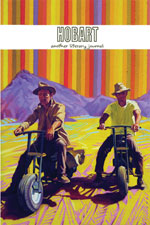(return to: website archives || main print issues website || minibooks)
order HOBART #12 now!
(out April 2011)
Two Notable Emotion Pianists
Sean Adams

Niles Pemburton: (1964 – present) Born in Iowa City, Iowa to Marsha, a music teacher, and Gilbert Pemburton, a physical therapist, Niles Oliver Pemburton is often seen as the father of the modern school of emotion piano composition called “emotio-robics,” in which the musician attempts to invoke as many surprising emotions in the listener as possible with little to no regard to rhythm or song structure.
Pemburton, An only child, learned piano from his mother during her summers off. In 1973, he moved with his parents to Fairfield, Iowa, where they joined the town’s blossoming Transcendental Meditation community. Pemburton often cites this move as his primary inspiration for emotio-robics: “All that calmness everywhere, it was like god damned brain suffocation. After so much sitting still, I just wanted to make people twitch.” Critics have described his music as “glorious food poisoning for your feelings” and “tobogganing along an emotional stock chart.”
In 2005, he shocked the world of emotion piano enthusiasts by announcing that he wrote several of his most noted compositions by sprinkling catnip across the keys and letting his cat, Milford, run across them.
Michale Henderson: (1923 – 1994) residing for most of his adult life in the his sister Lane’s suburban Minneapolis home, Michale Boneton Henderson was known for his short, plump stature, his pungent odor (described by concert attendees as resembling “good food cooked long ago”) and his deeply resentful nature.
Henderson attended a magnet high school for the musically gifted and, upon graduating, trained to be a concert pianist. Looking to earn some spending money, he was hired to play piano in the Grand Room of the Ten Thousand Lake Lodge in downtown St. Paul. The lodge billed itself as “a place for nature lovers to come together,” which, Henderson learned on his first day, was a euphemism; the building’s primary purpose was to serve as a space in which deviants could host orgies, sex parties, and other perverted, intercourse-centric activities. Henderson also found that his piano was an emotion piano, then a relatively new instrument, and the club required that he only play the keys of pleasure. “It was as I watched the throbbing, pulsing mass of bodies stowed in one another,” he wrote in his journal, “that I understood the emotion piano to be superior to its emotionless ancestor.” Henderson, from that point on, devoted himself solely to the emotion piano.
Many critics credit Henderson with being the first emotion pianist to incorporate multimedia into his performances. His concert involved him striking ominous, unpleasant chords while projecting slide shows of various people and things that he disliked. The pictures’ subjects ranged from passers-by that had not smiled at him, to women that refused to sleep with him, to bowls of yogurt, a food that he absolutely abhorred. Henderson believed that by playing enough emotionally unfavorable chords he might leave a negative imprint on the listener, which he or she would from then on connect with the person or object pictured. While many considered his work “spiteful” and “mean-spirited,” Henderson, himself, always referred to his compositions as “educational.”
by Douglas Silver
by Debbie Graber
by Karl Taro Greenfeld
by Melinda Moustakis
by Etgar Keret
by Sean Adams
by Robert Baumann
by Aubrey Hirsch
by Roxane Gay
1 issue = $10 + s&h ($2.00)